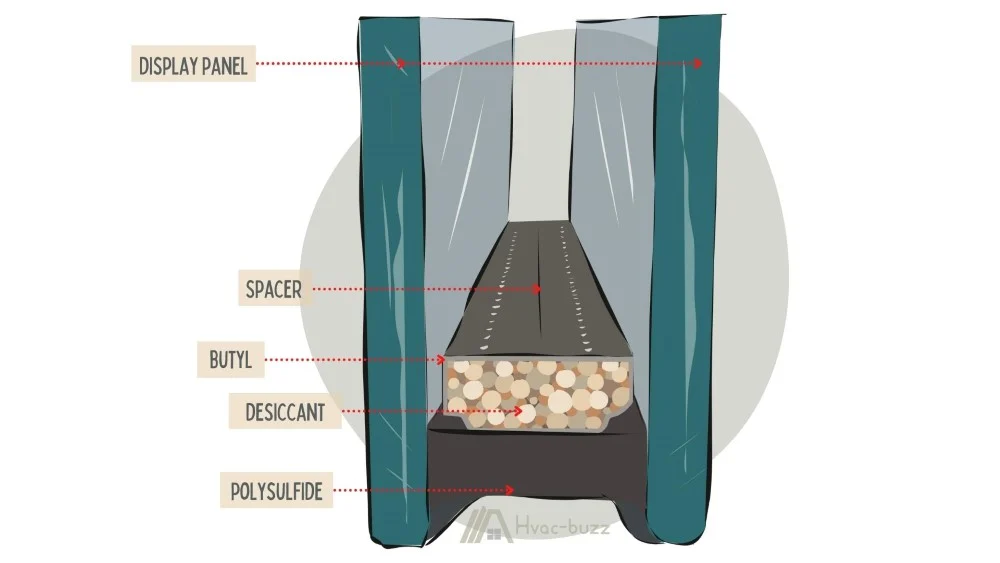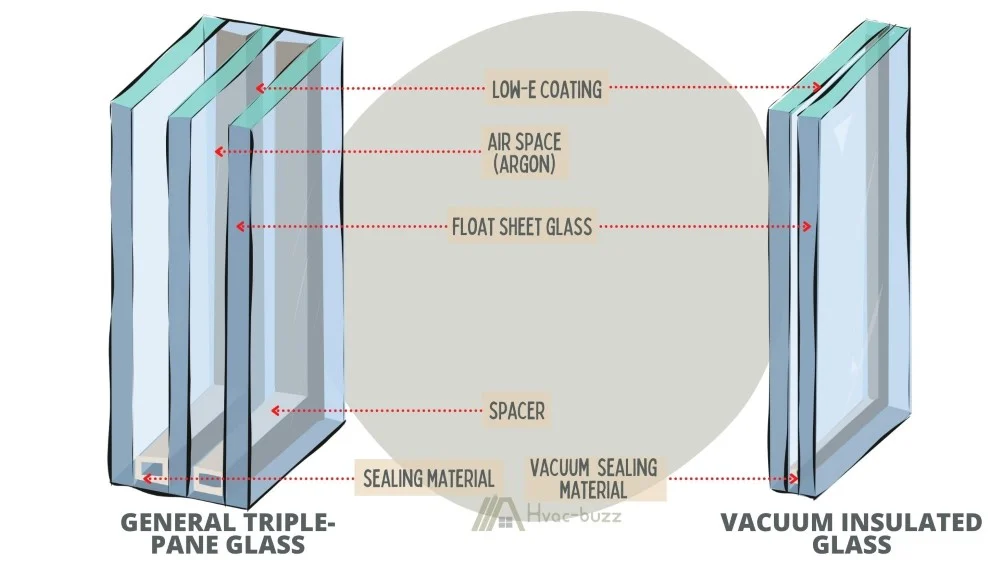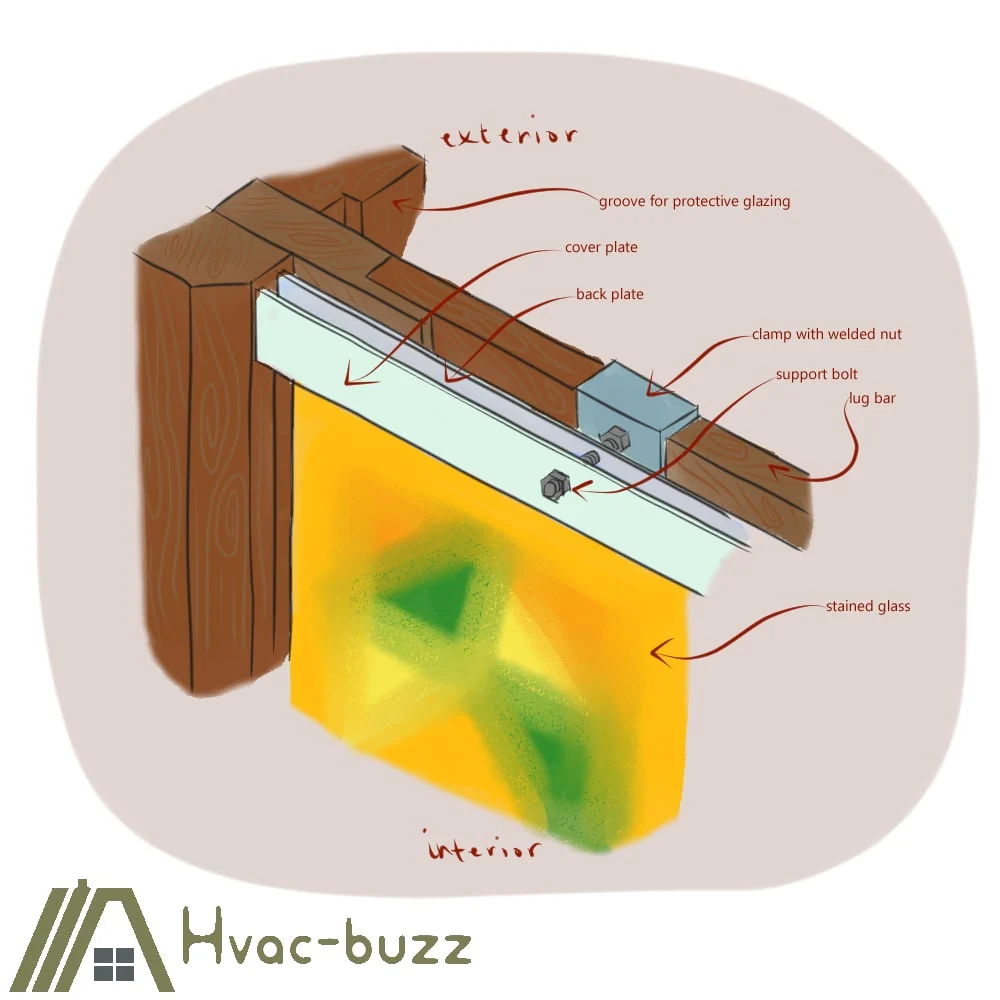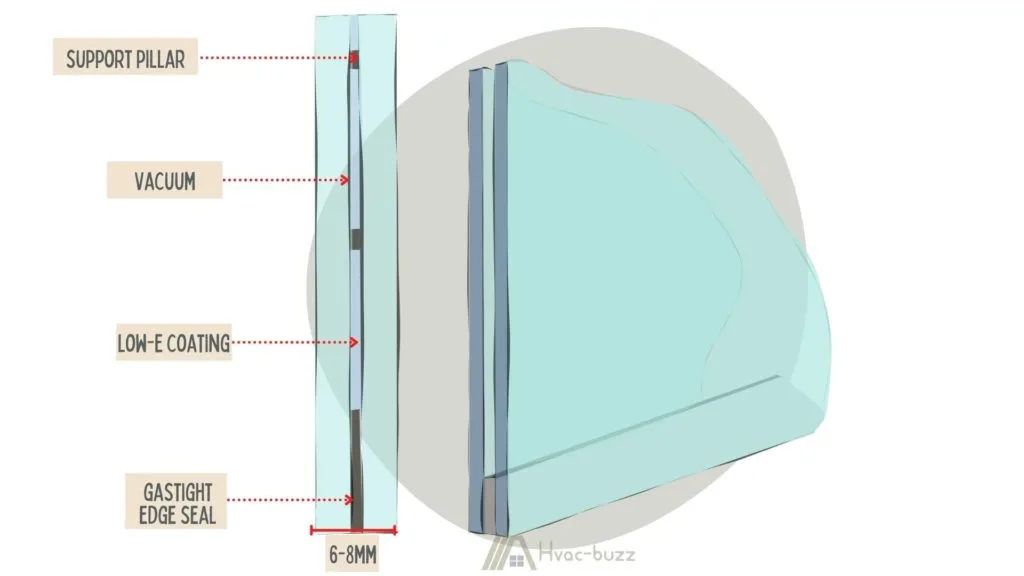When it comes to home insulation, double-glazed windows, which consist of two panes of glass separated by an inert gas-filled space, have been a homeowner’s go-to for many years. However, there is now a new contender on the market: vacuum-sealed windows.
So, how do vacuum-sealed windows compare to their traditional double-glazed counterparts, how common are they, and how does the design work?

Vacuum-sealed windows are double-paned, but not all double pane windows are vacuum-sealed. The most common kind of double-pane windows are double-glazed. Vacuum- and double-glazed windows consist of two glass panes separated by a space, but in one the space is void of matter, and in the other it is gas-filled.
Double Pane Windows May Be Vacuum-Sealed
A double pane window is one that is constructed with two sheets of glass separated by a small space (this space forms the basis of different methods for determining if a window is single- or double-paned).
Double-glazed windows are the more well-known version of a double-paned window, so much so, that the terms are often used synonymously. Normal double-glazed windows consist of two glass panes with a 0.8″ (20 mm) gap between them. The gap is most often filled with an inert gas, such as Argon, for thermal insulation, but sometimes it can be filled with regular air.
However, double-glazing is not the only form of double pane windows. Vacuum sealing, also known as Vacuum Insulated Glazing (VIG), creates a vacuum between two window panes.
The space separating the two panes is much smaller than in double-glazing; it is only 0.008″ (0.2 mm), yet they reduce thermal conduction and convection more effectively than a normal double-glazed window. It is even more effective than triple-glazed windows and has great acoustic and sound-reducing abilities.
What makes them so effective? Well, if you think about it, heat is transferred on a molecular level. Even inert gases, while poor conductors of heat, are still composed of molecules and are, therefore, capable of transferring heat. A vacuum is completely void of matter, so there is nothing to transfer the heat from one pane of glass to the other.

The same principle applies to sound transmittance. Sound cannot move through a vacuum.
How Are Windows Vacuum-Sealed?
Like double-glazed windows, vacuum-sealed windows consist of an outer and inner pane with low emittance (low-e) coatings. The air enclosed between the two panes is extracted through a plug on the inner pane.
As mentioned, this vacuum leaves a gap of only 0.008″ (0.2 mm), which is maintained by a grid of minute pillars that are 0.02″ (0.5 mm) in diameter and are evenly spaced between the glass panes. This ensures that the gap remains even throughout, and the glass doesn’t bend or break under that stress.
Once the air is extracted, an airtight seal is added along the edges of the panes to keep a stable vacuum and prevent other gases from entering the gap and reducing its insulating abilities.
Cost of Vacuum-Sealed Windows
Vacuum sealing is a recent technique, thus, production and installation costs can be hard on your wallet. Manufacturing costs of vacuum-sealed windows are approximately 25% higher than those manufacturing costs of gas-filled double-glazed windows.
If two sheets of low emittance glass were used for vacuum glazing it would cost around $40. If only one sheet of low emittance glass were used (the second pane would be made of regular glass) it would cost around $32.
Can Moisture Build up in Vacuum-Sealed Windows?
Air contains moisture and because there is no air in the gap between the two panes, no condensation can occur between the panes as it may do for double glazed windows that have air-filled gaps and are not inert gas-filled.

However, because the vacuum glazing doesn’t allow the transfer of heat, only the outer side of the outer pane may see condensation occur during Spring and Autumn. But it slowly disappears as the day warms up. Sometimes a clear border will form around the condensation on the outer pane as more heat is transferred through the window frame, creating this effect.
Can Stained Glass Windows Be Vacuum-Sealed?
The panes used in this technique are preferred to be plain low-e coated glass panes. Stained glass windows are very decorative pieces that are made up of multiple components. Patterns and pictures are created using cut glass pieces of various colors that are soldered together using lead.
These soldered spots are weak spots in the piece and may break if it’s under the stress of vacuum glazing. If you are lucky enough to have such a decorative piece in your home, then it may be best to rather double glaze or isothermally glaze your stained glass windows to protect them and increase insulation.
Double-Glazing Is More Common
While vacuum-sealed windows are double-paned, not all double-pane windows are vacuum-sealed. In fact, most are not. Most are double-glazed.
The double-glazed method became popular and easier to purchase in the USA in the 1950s and 1960s and was used in most homes. Thus, most homes and older buildings from these decades would have double-glazed windows.

Vacuum-sealed windows are more of a recent technique and were only really birthed in the 1990s. Currently, these windows are only used in specific places, for example, Japan only uses them in high-rise buildings, and the UK and North America only use them within historic buildings.
Double-Glazing vs. Vacuum Sealing
The only common factor between double glazing and vacuum sealing or glazing is that both require two panes of glass. Let’s have a look at their differences.
Double-Glazing
- 0.8″ (20 mm) gap filled with air or inert gas.
- If air-filled, more prone to have moisture build-up between panes.
- Heavy.
- Can be used to preserve historical pieces like stained glass windows.
- Affordable.
Vacuum-Sealing
- 0.008″ (0.2 mm) gap filled with no air or gas.
- Less prone to condensation between panes as no air is present between the gap.
- Lightweight.
- Not meant for stained glass windows, but able to maintain older building window frames as less work would need to be done to it.
- Expensive.
- Better insulator.

Due to its affordability, it may be best to use the double glaze technique for homes and shop windows. Vacuum sealing is more expensive and may be best for high-rise buildings that experience extreme temperatures.
However, should the demand and production of this product become popular over the years, it may become more affordable and accessible to homeowners and may be a more sensible option for all windows.
Sources
https://news.panasonic.com/global/press/data/2019/12/en191212-2/en191212-2.html
https://www.nachi.org/condensation-double-paned-windows.htm
https://en.wikipedia.org/wiki/Insulated_glazing
https://www.mrwrights.com/has-a-vacuum-seal-break-damaged-your-window/
https://www.gowercroft.co.uk/news/what-is-vacuum-glazing/
https://www.matec-conferences.org/articles/matecconf/pdf/2019/31/matecconf_cesbp2019_02020.pdf
https://glassdoctor.com/expert-tips/all-about-window-glass/condensation-on-inside-of-windows
https://www.youtube.com/watch?v=iPch3hq8154
https://maghulldoubleglazing.com/how-does-double-glazing-work/
https://www.glassonweb.com/article/past-present-and-future-vacuum-insulated-glazing-technology
https://www.thebalancesmb.com/cost-benefits-and-drawbacks-of-argon-gas-windows-844558
https://en.wikipedia.org/wiki/Thermal_radiation
https://glassdoctor.com/expert-tips/all-about-window-glass/condensation-on-inside-of-windows
https://www.traditionalbuilding.com/product-report/vacuum-insulated-glass
https://thetibble.com/stained-glass-double-glazed/
https://www.cloudy2clearwindows.co.uk/news/history-double-glazing/

